|
|
Worcester Park 2008
Why Worcester
Park?
Why Worcester Park? As we have said before, suburban
London is a product of its transport history. And in some
cases, transport history is a result of suburban London. The
area around Worcester Park grew up around the railway, built in
1859 to link Wimbledon and Epsom, which crossed the main road by a
bridge with limited clearance. This is the story of that
bridge.
When the London General Omnibus Company started route 213 (then numbered 113) from Kingston to Sutton
in 1921, the route had to use single-deck buses because of this
bridge and that at New Malden Station. Single-deck buses, with two
crew but half the number of passengers, were generally uneconomic
and London Transport preferred wherever possible to convert routes
to double-deck.
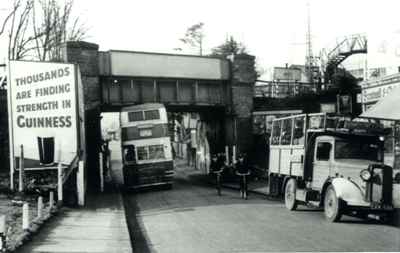
Newly double-decked in 1941,
the 127 was initially operated by borrowed Manchester Corporation
buses. Note that, unlike the Scooter shown above, the loaned
buses did not carry the black-out white circle on the back.
Photo Charles Klapper ©
Omnibus Society, Alan Cross collection
Other routes in the area were operated by
standard double-deckers, and as a result could not pass under
the bridge. Worcester Park Station has therefore been an
enforced terminus of buses arriving from the west, including over
the years routes 5, 32, 77A
and 189.
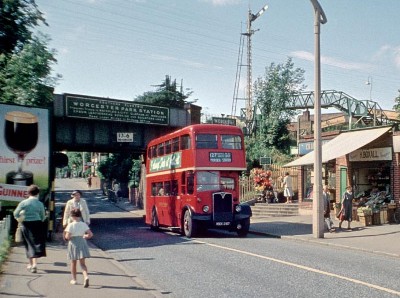
August 1958, and the 127 is about to be
withdrawn; RLH67 heads for Morden. The bridge now carries the
usual 'Frequent Electric Trains' sign, and a height warning
notice. The Guinness ad is still in place but has been
updated.
Photo © Bruce Jenkins (thanks to
Bruce for the loan of the slide)
The road beneath the bridge was lowered in 1962. This was
achieved by building a second carriageway to the south, then
lowering the original road to produce today's dual
carriageway. The road was completely closed for only one day,
Sunday 4 Nov 62, on which day the 213 worked in two sections.
See photo sequence by Andrew Hicks.
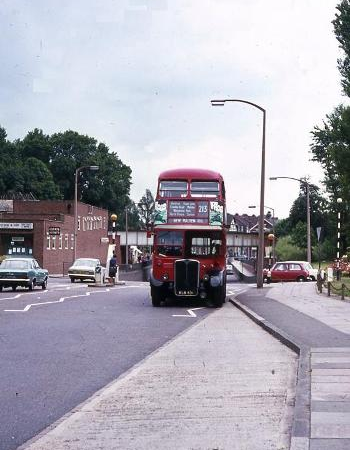
After the bridge was rebuilt, the 213 was
converted to double-deck RT operation in 1963. The RTs
continued to operate the route until 1972. Here, near the end
of RT operation, RT1282 on a short-working to New Malden passes
Worcester Park Station with the bridge in the background. The
zebra crossing has now been replaced by traffic lights, but
otherwise the scene is much the same.
Photo © John
Parkin
|

Wartime - LT1060 on the 213 runs under the
original bridge, which at that time did not have a height indicator
affixed. The board advertising trains and the station sign
itself have presumably been covered as part of the campaign to
remove location and direction signs. Note the white-painted
bridge buttress, to assist in the black-out.
Photo Charles Klapper © Omnibus
Society, Alan Cross collection
Whilst the road was lowered beneath the New Malden bridge
earlier, double-decking couldn't happen to the 213
until Worcester Park bridge was rebuilt in 1962. However, to support the
demand from factories in the area, the other route to run
under the bridge, the 245, was double-decked in 1941 and
renumbered 127. In doing so, it
became the first route in London Transport's red bus area to need
low-height buses, specially built to be a foot lower than standard
buses. There were none spare, so for the first few months,
buses borrowed from Manchester were used.
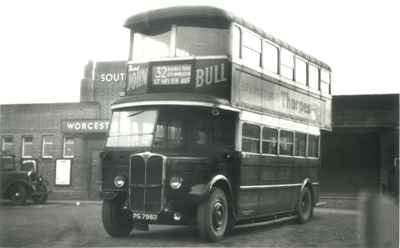
Full-height green ST1113 operating route 32 in
1949 and standing at its terminus at Worcester Park Station.
The route could go no further due to the low bridge.
Photo © Alan Cross
Route 127, meanwhile, progressed from borrowed buses to those
transferred in from the Country Area and some of the new
Chiswick-built STLs, then low-height utility Daimlers and finally
the RLH class in 1952.
One of Worcester Park's claims to fame is that this is the only
low bridge under which both red and green RLHs worked on scheduled
services. This was because Green Line 725 from Windsor to Gravesend, usually
worked by single-deck coaches, ran special extra journeys as far as
Croydon on summer Sundays in the mid-1950s with green RLHs loaned
from Addlestone garage.
Operation of the 127 ended in August 1958, after which the 213
(now RF-operated) was the sole route to run under the bridge.
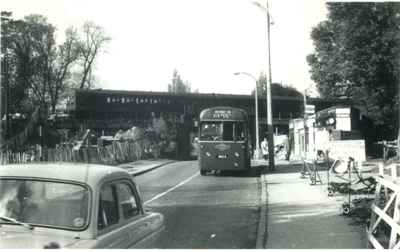
Seen on 28 Oct 62, RF369 heads southeast
towards Belmont on the old road, with work under way on the
new northbound carriageway. A Southern Region 4-SUB works
overhead to Epsom and beyond. The classic railway row of
shops to the right of the picture still survive - Cuppaholic will
provide refreshment for your visit.
Photo © HE Murrell, Peter Osborn
collection
This was of course the trigger for conversion to RT operation,
for which a diversion at Norbiton was required to avoid the
unreconstructed low bridge there. It came with the new summer
timetable in May 1963, when the route became two routes, 213 and
213A, diverging between Malden and Coombe Lane.
Today, there is little but the dip in the road to show the way
the original bridge looked. Except that the row of shops next
to the bridge, now above road level, continue to serve
travellers.
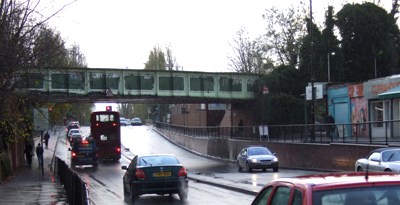
Today's scene on a wet winter day, the new
bridge looking rather tatty and the 151 now terminating in the
station forecourt from the east.
Photo © Peter Osborn
|